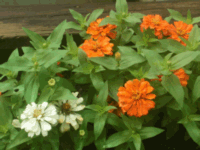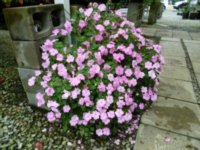
Mulching
All garden beds should be mulched with about 2 to 3 inches of material; such as chopped leaves, pine straw, pine bark, black plastic, newspaper, cardboard or other suitable materials. Mulches help considerably but are not totally weed-proof. If weeds manage to make it through the mulch, dig the weeds out promptly, making sure you get any bulbs or roots that might sprout again out of the ground. Mulches help prevent soil splash which can spread diseases and insects, and also keeps garden beds tidy. As mulch breaks down, it provides organic matter to your soil which improves soil health and tilth.

Zinnias in the Landscape
Zinnias are a popular warm-season annual. They perform best in full sun and fertile, well drained soil. They are adaptable to a wide range of growing conditions however. Zinnias come in many plant forms, ranging from the old giant types (Z. elegans),with tall erect stems growing to over thirty inches and becoming woody and advanced age before flowering stops in late autumn, to the lower, more sprawling and smaller , single-flowering types (Z. angustifolia) which branch and bloom over an extended period. Z.haageana, the Mexican zinnia, grows to about 15 inches tall and produce bicolor flowers which are great for cutting. Zinnias are propagated by seeds planted in spring. Zinnias come in a variety of colors such as red, orange, green, pink, yellow and many varying shades of these.
Zinnias are easy to grow when grown under the right conditions. Plant in raised beds with well drained soil which gets sun all day. It thrives in hot, sunny locations. Fertilize every three to four weeks with a 20-20-20 formula during the growing season. Provide good air circulation to avoid mildew problems by planting six to eight inches apart. Staking may be necessary for tall varieties. Deadhead spent flowers to encourage more blooms and branching. Zinnias are annuals and must be planted every year in spring but in some old established gardens self-seeding can occur. Some popular varieties are, ?Big Tetra?- large flowers with bright flower colors, Cool Crayon Colors?- Double, long stems in deep lavender rose, pink and white. „Crystal White?-Narrow leaved produce white daisy-like flowers with yellow centers. It blooms many weeks from summer to fall. ?Profusion White” has excellent white blooms.

Landscaping with Periwinkles
Every year problems occur with landscape plantings of periwinkles (Catharanthus roseus) across Louisiana. Phytophthora root and stem rot is the typical disease responsible for most problems. Root rot and rotting of the lower stem just at and above the soil line are characteristics of the disease.
For success with periwinkles, consider these tips:
1. Select a full sun location. Periwinkles need eight hours of full sun daily for optimum performance.
2. Prepare the landscape bed properly to provide good drainage and aeration. Raise the bed at least 6 inches, since internal drainage is essential.
3. Avoid early planting; plant in May. This allows the soil temperature to rise, and conditions are more favorable for root establishment and expansion.
4. Pay attention to planting depth. Planting individual cells/plugs/plants too deeply increases exposure of the root system and lower stem to unfavorable growing conditions.
5. Mulch properly to decrease splashing of rainfall and irrigation water from soil to the lower stems and foliage. Bedding plants should be mulched to a depth of 1 to 2 inches. Avoid excessive mulching.
6. Manage irrigation properly. Periwinkles require minimal irrigation and frequently are over-irrigated. Avoid overhead irrigation. It increases the incidence of alternaria leaf spot.

7. Don’t plant periwinkles in the same bed during consecutive years. Rotate with lantana, blue daze, pentas, melampodium, scaevola or sun coleus.
8. Consider using the Pacifica series of periwinkles. These have been among the top performers in LSU AgCenter trials.
9. Fungicides labeled for control of Phytophthora in landscape beds used for bedding plants include those containing aluminum tris (Aliette), etridiozole (Terrazole and Koban), metalaxyl (Subdue) and propamocarb hydroxide (Banol).
Vegetable Gardening
Plant these vegetable seeds during this month: cantaloupe, collards, corn, cucumber, cucuzzi, cushaw, honeydew, lima beans, luffa, Malabar spinach, mirliton (plant sprouted fruit), okra, pumpkin, snap), potato (“slips”), Swiss chard and watermelon. Plant transplants of eggplant, peppers and tomatoes.
Tomatoes
Begin transplanting plants in mid-March in south Louisiana or at the end of March in north Louisiana – after the danger of frost is over.
If a frost occurs, you will need to cover the newly planted plants! To avoid severe damage from diseases and insects, spray tomatoes after fruit set every seven to 10 days with a fungicide (Daconil or Maneb) and an insecticide (Sevin or Malathion).
Plant tomatoes in a well-drained site, that receives six to eight hours of direct sunlight each day. When tomatoes receive too little sunlight, few blossoms form and many that do form will fall off before setting fruit.
Space tomato plants 18-24 inches apart. Fertilize with 5-6 pounds of 13-13-13 prior to planting and side-dress at first and second bloom with calcium nitrate or potassium nitrate.
Tomato vines may be determinate or indeterminate. Indeterminate types have a vegetative terminal bud that continues to grow. Determinate types have a fruiting terminal bud that keeps the plant from growing beyond a predetermined height. Determinate types are better suited for container gardening. Indeterminate types will need to be staked in the garden.
Indeterminate varieties that grow well in Louisiana include Better Boy and Big Beef (large), Champion and Pink Girl (pink), Sweet Million, Sweet Chelsea, Jolly, Small Fry, Juliet, Elf, Elfin, Navidad, Cupid, Mountain Belle and Sun Gold (cherry).
Determinants have very productive vines that grow to heights of 4 feet. Stems terminate in a flower cluster. Determinants should be pruned only once or twice up to the first cluster.
Recommended determinate types for Louisiana include Celebrity (an All-America Selections winner, best taste), Carolina Gold, Fla. 47 or 91, Mountain Spring, Cherry Grande (cherry), Floralina, Mountain Fresh and Mountain Crest. Also try Sun Master, Sunleaper, Summer Flavor 6000, Mountain Spring and Phoenix.
Note: The tomato spotted wilt virus has nearly eliminated tomato production in some areas. If you had this trouble, plant Bella Rosa, Mountain Glory, Amelia, Crista, Quincy or Talladega varieties.
Bell peppers and Eggplants
Wait to transplant okra, bell peppers and eggplants until the weather has warmed considerably. These vegetables are sensitive to cold soils and weather. Once stunted by cool weather, they recover slowly.
A garden site with full sun is required for growing bell peppers. Any shade will greatly reduce fruit set. Space peppers about 12-18 inches and eggplants about 18-24 inches apart.
Recommended nonhybrid varieties of bell peppers for Louisiana are Capistrano, Jupiter and Purple Beauty.
Recommended hybrid bell peppers are Revolution, Heritage and the large King Arthur, Valencia, Paladin and Plato. For a yellow bell, try Orobelle, Summer Gold, Valencia or Summer Sweet 8610. For a mature red bell pepper, try Camelot (X3R) or Aristotle.
Yellow and red bell peppers are difficult to produce in our humid conditions. (Note: Tomato spotted wilt virus has hindered bell pepper production in many areas.) The varieties Stilleto, Patriot and Excursion II are resistant to tomato spotted wilt virus. Try these varieties if you have had trouble producing bell peppers.
Recommended hybrid eggplant varieties are Fairy Tale, Night Shadow, Blackbell, Calliope, Classic, Epic, Dusky, Santana, Rossita or oriental Ichiban. The green eggplant varieties produce well in Louisiana and are less bitter than the purple varieties in hot, dry weather. The Louisiana Market Bulletin is a fairly good source for green eggplant seed and other hard-to-find vegetable seeds and plants.
Cucurbits
All squash, cucumber and melon members of the cucurbit family can be planted in May, but yields may be lower than normal with the late plantings. Plant cucurbits outdoors, well after the danger of frost is over. Do not keep transplants in pots longer than three to four weeks prior to planting in your garden.
Recommended cucumber varieties for slicing are Talladega, Dasher II, Olympian, Fanfare AAS, Diva AAS, General Lee, Speedway, Poinsett 76, Slice More, Thunder, Indy, Intimidator, Sweet Slice and Sweet Success.
For pickling, try Calypso, Fancipak and Jackson. Recommended summer squash crooknecks are Prelude II, Dixie, Gentry, Goldie, Supersett, Destiny III and Medallion.
Recommended yellow straight-neck squash varieties are Goldbar, Liberator III, Enterprise, Cougar, Multipik, Patriot II, Superpik, Fortune and Lemondrop.
Recommended zucchini varieties are Declaration II, Justice, Independence II, Tigress, Lynx, Spineless Beauty, Senator, Gold Rush (AAS), Payroll, Revenue and Dividend.
Recommended scallop or patty pan squash varieties are Peter Pan and Sunburst.
Recommended hard shell (winter) squash varieties are Waltham, Butternut, Butternut Supreme, Early Butternut, Ultra Butternut, Tay Belle Acorn, Cream of Crop Acorn (AAS), Table Queen, Table King (AAS) and Imperial Delight.
Viruses are a big problem in squash production. Try planting some of the new virus-resistant varieties: Prelude II and Destiny (yellow crookneck); Liberator and Conqueror (yellow straight neck); and Declaration, Payroll, Judgment III, Revenue and Independence (zucchini).
Recommended cantaloupe varieties are Aphrodite, Athena, Primo, Magnum 45, Super 45, Ambrosia, Earlidew or Honey Max.
Sweet Potatoes
Plant seed potatoes in beds during April, and into May. Transplants should be ready to cut in four to five weeks. Sweet potatoes slips (transplants) can be set out in late April if soil is warm enough (greater than 70 degrees Fahrenheit). Cut plants from plant bed about 1 inch above soil line and transplant. Purchase weevil-free plants.
Cutting rather than pulling, helps reduce sweet potato weevils and many disease problems. Cuttings develop feeder roots within a day or two if the soil is warm and moist. Holding the cut slips in the shade for two to three days before transplanting will help increase survival. Use a low-nitrogen fertilizer such as 6-24-24 or 8-24-24 at 2-3 pounds per 100-foot row.
Beauregard, developed by the LSU AgCenter, is the most popular variety. It is high-yielding, very attractive and tastes great. Bienville, another LSU AgCenter variety, requires a sandy soil.
Okra
Soil needs to be warm (65-75 degrees) for okra seeds to germinate. Soak seeds overnight in tap water to soften seed coat before planting.
Recommended varieties are Louisiana Green Velvet, Emerald, Annie Oakley (hybrid), Cowhorn, Cajun Delight-AAS, Burgundy and Clemson Spineless. Each of these varieties, except Louisiana Green Velvet, is semi dwarf.
submitted by Karen Blackburn
